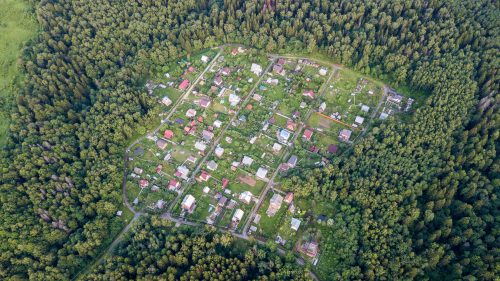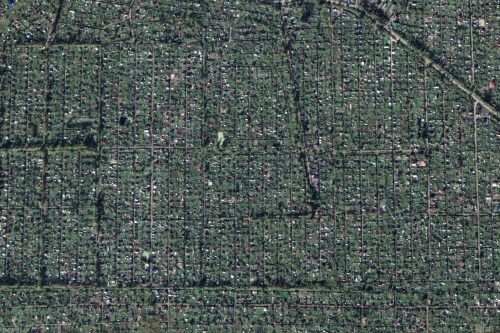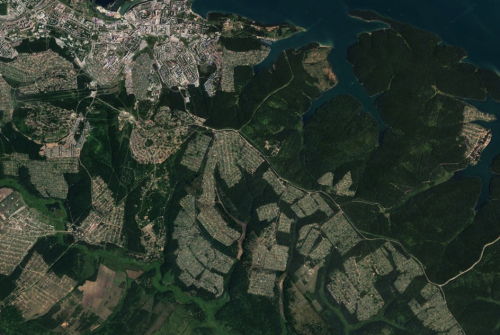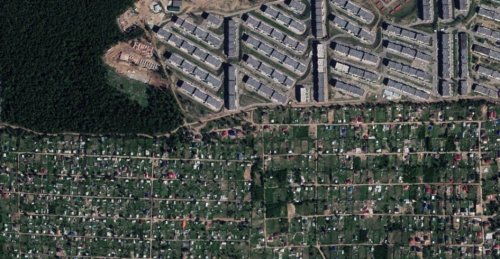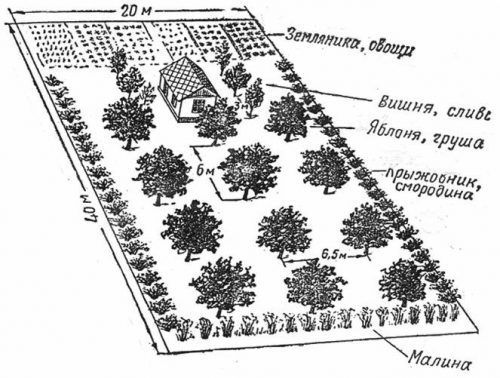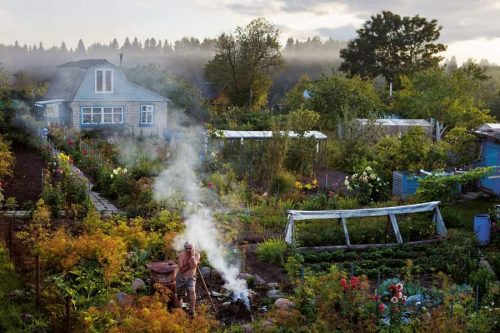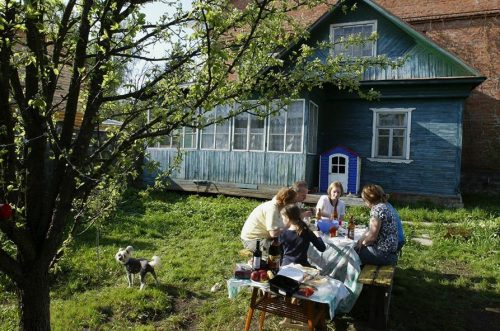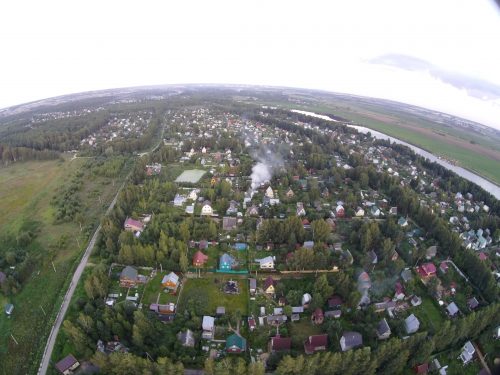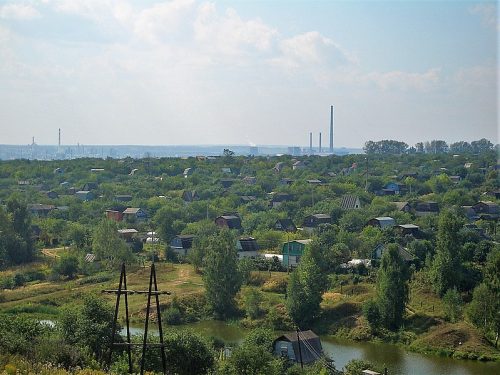Russia’s large-scale peri-urban community agriculture has proven to be a very resilient food system. In this guest post, Arthur Grimonpont investigates the phenomenon and wonders if it could be reproduced in other industrial nations, for example in France.
Image: Dacha settlement, Kursk Oblast, by Petr Magera (CC BY 2.0).
This article was written by Arthur Grimonpont, and originally appeared in Les Greniers d’Abondance under the title Les collectifs de jardins russes : une organisation résiliente. Translated from French by Beth Lindfield and Alice Essam, adapted by Kris De Decker.
The Scale of the Concept
Satellite images demonstrate the undeniable importance of community gardening in some Russian cities. From the sky, you can see vast, continual mosaics of plots lined with trees, gathered together in pockets or strips on the outskirts of almost all city centres.
Typical community gardens seen from the sky on the western outskirts of Iaroslav, Russia.
In Irkoutsk, the most populated city in Siberia located next to Baikal Lake, community gardens have become immense neighbouring forests.
A neighbourhood in the south-west of Irkoutsk.
The Russian Gardener’s Association estimates that of the one hundred million people in Russia, sixty million engage in gardening activites in order to produce food. [1] Even in the largest cities, such as Moscow or St Petersburg, over half of the population has an arable plot. These people are called gardener-inhabitants, or datchniki. In provincial towns, such as Kazan, their number can reach as high as 80% of the population. [2] Throughout the country, there are an estimated 80,000 garden communities, which range from around ten to a few thousand plots. [4]
Origins and Description of Community Gardens
Garden communities (similar to allotments in the UK) appeared in 1917, following the increasing and worsening food shortages after the Russian state established a monopoly on food production. The gardens, informal by origin, were originally disapproved by Soviet powers. However, they quickly became managed by the state due to their undeniable efficiency in counteracting the shortages. The communities were controlled by state businesses that divided the property into equal plots and distributed them to employees. [3]
A drawing of the guidelines of a plot. (Source: Revue Jardins aupres des Oussas’bas, Moscow, April 1959, p.13)
The arrangement of the gardens was the objective of strict management. The law even enforced a certain number of apple, pear, cherry and plum trees, and raspberry and blackcurrant bushes, as well as defining a minimum area for strawberry plants and vegetable patches. The majority of plots have a surface area of 600m² (a rectangle of 20 metres by 30) and are called the “six-one hundred square metres” in Russian. In general, they have a “garden house”, or datcha, which serves as a temporary living space, as well as for storing gardening tools and harvested fruits.
It is evident that these Russian allotments offer few points of comparison with French allotments, which are much smaller (around 30 m²), don’t allow their occupants to stay there, and are historically reserved for poor people. [5]
Local Footing
The immediate proximity of these gardens to where their occupants live establishes their reason for being. Developed during a time when using cars was rare or even non-existent and free time was rare and sought-after, the allotments were located close enough to town centres for people to get to on foot or by public transport (which was the almost exclusive mode of transport for city dwellers until the 80s).
A ban on the commercialisation of harvested produce guarantees that it is only consumed locally. In the rural city of Kazan (1.2 million inhabitants), the majority of datchniki that were asked said that, thanks to their gardens, they had managed to feed their families for at least the summer. With certain produce, such as potatoes, some even managed the whole year. Potatoes are some of the most cultivated vegetables, with farming statistics showing that nearly 80% of potatoes from the Kazan region are grown on these plots. [19,20]
Datcha and luxurious garden in Valdai, in the Oblast of Novgorod. Photo by Jonas Bendiksen
As well as significantly contributing to agricultural production, the gardens play a major role in making people’s diets more varied in urban populations: they provide them with access to a diet rich in fresh produce that they can’t always find by conventional means due to their high cost. [10] They consistently harvest potatoes, tomatoes, cucumbers and peppers, among many other crops. They also grow a lot of berries and fruit on trees. Many varieties are often cultivated for each type of plantation and annual flowers also often make an appearance. [11,12]
The moderate size of the plots and the ban on the commercialisation of the produce separate them from the agro-industry (seeds, fertiliser, tools) and from professional selling avenues: swapping and using your own produce are the only legal practices. [13] The datchniki don’t have to put up with fluctuations in the price of agricultural produce. Their harvest, little or not at all modified, doesn’t depend on any factories or mainstream infrastructure. The mixture of fruit trees, vegetable patch plants and ornamental crops creates a varied island of greenery. The gardens host great biodiversity, which decreases vulnerability to disease, pests and adverse weather conditions.
Resilience and Flexibility
Throughout the 20th century, the number of collectives and the intensity of their cultivation fluctuated a lot in accordance with economic conditions. Likewise, today the gardens are distinguished by the extent of their productiveness, which partly conveys the differences in social status between their occupants. The continental climate of Russia encourages the majority of datchniki to maintain a main place of residence and a job in urban areas, and to only temporarily occupy their gardens in the active season, stretching from May to September.
In recent years, more and more Russians are making the choice to live in their “six-one hundred square metres”, which have been made more comfortable by some recent transformations. With the relative political and economic stability of Russia in recent years, the number of cultivated plots has decreased and the plots are progressively used more for holidays than for agriculture. Most families who can afford to tend to give up their food-producing cultures, although they often keep a small part for family tradition. [6]
From the beginning of the spring until the first frost, millions of Russians make the most of their summer chalets. Photo by PhotoXPress
However, the system is flexible and its usefulness was made particularly clear during the disintegration of the Communist Bloc and the decline in production on kolkhozes and sovkhozes (state-owned Soviet farms in Russia) in the early 1990s. Russians were hit by the quick collapse of agro-industrial production and spending power (teachers saw their earnings cut by between 3 and 5 times). [14]
During that period, fears concerning sudden provisions shortages and the outbreak of famine spurred the United States and the European Union to devise huge food aid programmes. However, the aid was not necessary due to the revival of allotments: people quickly converted the lawns in their “six-one hundred square metres” into space for food growing.
A study from the UNDP (United Nations Development Programme) showed that as many as 65% of families in the city of Moscow engaged in urban gardening in 1991 compared to 20% in 1970. In the mid-90s, this urban gardening provided the majority of potatoes, fruit and vegetables eaten by people living in cities. This production represented between 20 and 30% of the total value of food production in Russia. [15]
A Model to Replicate?
In France, 57% of households have a house with 600m² of adjoining land as their principal dwelling. [23,24] There already, then, exist significant potentially cultivatable plots of land. To provide all homes without a garden with a 600m² plot on which to grow, around 18,000km² (6950 miles squared) of arable land is needed near city centres, which is about 6% of used agricultural land in France. [26] This is the equivalent of half of the current urbanised land area. [25,27]
Dachas Moscow Oblast. Image by Trasprd (CC BY 4.0).
This might seem like a lot, but consider that:
- Garden communities do not lay down unnatural floor (access paths must be permeable and cabins must be easily dissembled) and can host considerable biodiversity (much more than a monoculture plot), particularly if the size of the plot allows for trees to be planted. [28]
- With regard to halting urban sprawl, converting wasteland, neglected land and some peri-urban agricultural land into garden communities would improve the relative value of land, making possible its transfer and safeguarding ownership.
- Gardening, on a large scale, offers other societal benefits than just food production.
This last point is particularly visible in Russia, where we can observe that these communities:
- reduce low-income households’ dependence on social benefits
- help people who have experienced difficulties reintegrate
- improve health and life expectancy
- provide many people with and affordable place to get fit and spend leisure time
- give people a place to ride out continental summer heat waves, minimising both the heat island effect and providing somewhere well adapted to the hot season.
The suburban model, the main mode of urban growth in France since the 1970s, is by all accounts unsustainable but undeniably meets a proportion of the French populations demands. [31] Garden communities offer a credible response to individual aspirations, without externalising harm to common interests and good.
Recent Evolutions and Uses
Allotment plots officially remained property of the state until 2006. They have since been transferred into private hands at a rapid rate. The increase in the standard of living and the loosening of rules have also meant that there is a higher number of permanent structures within certain communities. This change is often accompanied by the merging the plots to make them bigger, installing gas and electricity, and strengthening access roads. The community gardens are therefore moving significantly towards the model of European housing estates. [7]
Kstovo’s industrial area (CC BY 2.5).
These changes cause inequality among community gardens, especially those next to the most important cities. Subsequently, these changes have put pressure on property and, more interestingly, on property developers who generally already have access to water and gas. By contrast, in some suburbs far from the city centre, gardens have been abandoned by their owners. [8]
At the beginning of 2019, the legal system managing the communities was standardised in attempt to prevent these kinds of deviations. In particular, the right to build is now managed in a standardised way by local planning regulations. [9] Despite the changes observed in recent years, urban gardening remains in cultural heritage and a tradition for tens of millions of Russians.
Arthur Grimonpont
Original article: Les collectifs de jardins russes : une organisation résiliente.
Notes and References
1. Estimates are difficult to make because of a lack of a clear legal status; they vary from 45 to 67 million, according to different authors. 60 million is indicated by : https://versia.ru/obshhaya-ploshhad-dachnyx-uchastkov-v-rossii-sostavlyaet-desyat-territorij-moskvy
2. Marloie M., Boukharaeva, L., 2011. Des sols agricoles au service de la résilience urbaine : réflexions à partir du cas de la Russie. Espaces et sociétés, 147, p. 135-153
3. Marloie M., Boukharaeva, L., op. Cit.
4. Specialists note the difficulty in making a precise estimation of this number in the absence of an official consensus, and given its constant evolution. Estimate provided by: Marloie M., Boukharaeva, L., op. Cit.
5. Guyon, F. 2008. Les jardins familiaux aujourd’hui : des espaces socialement modulés. Espaces et sociétés, 3(134), p. 131-147
6. Robert-Bœuf, C. 2014. Les jardins collectifs à Kazan: une agriculture familiale entre espace productif et espace résidentiel. POUR 4(224), p. 101-109
7. Robert-Boeuf, C. 2017. Cultiver la ville en Russie, Géographie et cultures, 101, pp. 17-34.
8. Translated from the Russian website: https://rg.ru/2017/04/26/kakie-izmeneniia-zhdut-vladelcev-dachnyh-uchastkov.html
9. A new federal law of July 29, 2017 No. 217-З entitled “Keeping citizens of gardening and gardening for their own needs and amending certain legislative acts of the Russian Federation” ame into force on 1 January 2019
10. Ortar N. 2005. Les multiples usages de la datcha des jardins collectifs. Anthropologie et sociétés, 29(2), pp. 169-185
11. Ortar N., op. cit.
12. Ortar N., op. cit.
13. This independence is of course not perfect. With regard to seeds, Robert-Bœuf C., op. cit., notes that “few gardeners save their seeds today, preferring, because of their relative low price, to buy them in specialised stores or in supermarkets”.
14. Marloie M., Boukharaeva, L., op. cit.
15. Marloie M., Boukharaeva, L., op. Cit.
16. Robert-Boeuf, C. (2017), op. cit.
17. Ortar N., op. cit.
18. Marloie M., Boukharaeva, L., op. cit.
19. Robert-Boeuf, C. (2017), op. cit.
20. Statistical data from the Ministry of Agriculture, Tatarstan, from 2012
21. FAO (2014), L’agriculture urbaine, http://www.fao.org/urban-agriculture/fr
22. Zezza, A. et L. Tasciotti. 2010. Urban agriculture, poverty, and food security: Empirical evidence from asample of developing countries. Food Policy, 35, p. 265-273.
23. INSEE (2018) https://www.insee.fr/fr/statistiques/2412780
24. INSEE (2006) https://www.insee.fr/fr/statistiques/1281267
25. In the absence of more precise data concerning the area of the spaces adjoining individual houses and their use (these can be waterproofed, serve as parking or a terrace), we arbitrarily consider that half of the gardens with an area of less than 600m2 do not lend to significant vegetable production. There are then around 60% of the 30 million French households to equip.
26. The French UAA represents 29 million hectares, or 290,000 km2, according to INSEE, Agreste.
27. Artificial soils, that is to say coated, built or made unfit for cultivation represent 3.4 million hectares, according to INSEE, Agreste
28. Most “working-class gardens” in France prohibit the planting of trees, and would be too small to accommodate them
29. Marloie M., Boukharaeva, L., op. cit.
30. Dacha owners spend most of their weekends there, from spring to fall, and many spend their entire holiday there: http://krizis-kopilka.ru/archives/2239
31. Dias D., Langumier J., Démangé D. 2008. Mutabilité du périurbain. Le modèle pavillonnaire face aux crises énergétique et environnementale. Les Annales de la Recherche Urbaine Année.104 pp. 149-156
